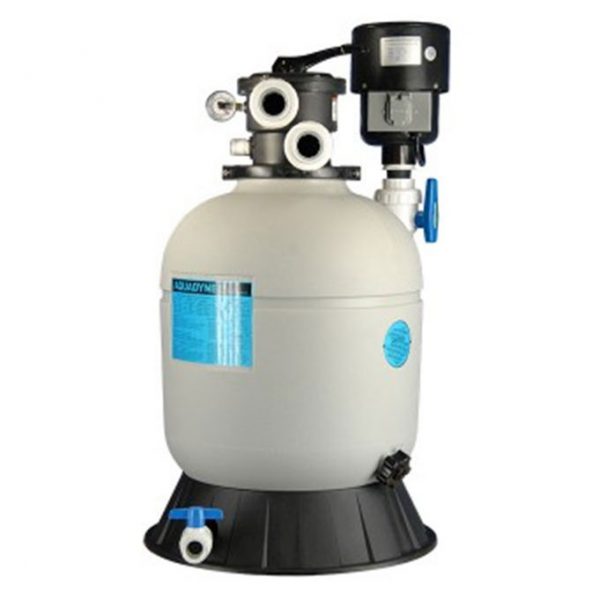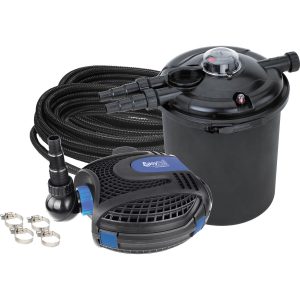Aquadyne 1.1B Professional Pond Filters – Up to 4000 Gallons – AD4000
Original price was: $2,280.00.$1,938.00Current price is: $1,938.00.
Pond Size – Up to 4000 Gallons
Fish Load – 8 5 Lbs.
Pump Size – 1000 to 4000 Gallons Per Hour
Plumbing Ports – 1 – 1/2 Inches
Plumbing Accessories – 3 ea. Self Sealing 1 1/2″ Unions Included
Head Pressure – 0 to 1 Psi at 2000 GPH on a clean cycled filter
Media Volume – 1.1 Cubic Feet
Media Weight – 40 Lbs.
Diameter x Height – 18-inches x 38-inches
Avg. Backwash – 30 Gal.
Out of stock
Receive in-stock notifications for this.
Description
The Aquadyne 4000 – Model 1.1B filtration system is the most efficient and most maintenance free system ever introduced to the industry in such a small package. Just check the performance data list in this listing. The AD4000 can also be used with submersible pumps with ease.
The Dynamax blower aggressively agitates the debris collected in the media bed and suspends it in the water column which is easily backwashed to waste. With the blower this unit will use about 30 gallons per backwash. The Model AD42000 will support up to 85 pounds of fish while feeding once per day. The AD4000 is excellently suited for medium to moderately sized indoor large volume aquariums or more heavily stocked laboratory research applications. Also works exceptionally well for medium to moderately sized aquatic environments for alternative species exhibits. Remember, when setting up indoor units it is always a good idea to install the water pump and filter body inside a tray with at least 2″ tall sides. You can get a water alarm from a Depot store to place inside the tray that will alarm in the case of an accidental leak from the plumbing or pump. This can save you against a messy indoor cleanup. High quality quick disconnect unions are included.
Backwashing:
Initially you will let your filter run for a period of several days up to two or three weeks depending on mechanical loading of removed solids. We recommend that you not backwash your new filter until it begins to load up with solids to the point of slowing your water flow down. This will allow naturally occurring bacteria including Nitrosomonas and Nitrobacter to cycle and form a living colony inside your filter media. If your water flow slows due to solids being removed from the water then by all means backwash it. Otherwise, resist the temptation to backwash the filter and let it be. You may leave your pump running when performing backwashing operations with few exceptions. We suggests turning the pump off, but you are free
to choose. See installers instruction manual for more details.
Backwashing With Dynamax Air Assist: Turn the main pump off, and place the main control valve in the
RINSE position. Plug in the Dynamax air blower and open the blower control valve. The system will belch a wave of dirty water and compressed air. Allow blower to run approximately 2 to 3 minutes, then close valve and switch off blower. Reposition the main control valve to BACKWASH then turn the pump back on (high speed if you have a 2 speed motor). When the sight glass begins to run clear, return the control valve back to filter and reset your pump to low speed (if you are using a 2 speed pump) and you are finished. This process takes 5 minutes max.
Backwashing Without Dynamax Air Assist: With the pump off or on, reposition the top control handle to the BACKWASH position. At first you will see only clear water flow out of the waste line, then the dirt and waste will begin to exit the filter. Once the water runs clear, reposition the handle to the RINSE position to reload the media into the top of the tank and allow the water to run again until clear. Finally, reset the control handle to the FILTER position and you are finished. Note: Rotating the control handle back and forth several times between Backwash and Rinse positions and finally back to Backwash greatly improves debris removal on non-Dynamax systems.
After each backwash, open the sludge valve at the bottom of the filter for 3 to 5 seconds after your control head has been returned to the filter position. This will discharge any sediment that has settled in the bottom of the filter tank during the filtration or backwash cycle. You will probably notice that the discharge from the waste lines will have a very foul odor. This is good, and a sign that your beneficial bacteria are developed and healthy. And most important!, plan on spending most of your time ignoring your filter system, because you will be free from worrying about cleaning your filter and free to enjoy your pond and its friendly inhabitants.
Additional information
| Manufacturer | |
|---|---|
| Filtration Type | |
| Filters Max Pond Size Range | |
| Filter UV Option | No UV |
| Pond Product Type | Pond Filtration |
| Series | Professional |
| Filter Max Pond Size |





